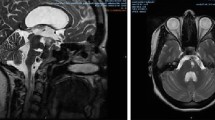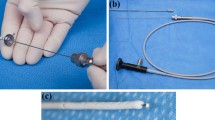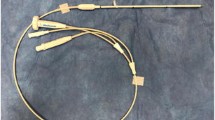Abstract
Purpose
Controversial issues exist concerning criteria for patient selection and long-term success in pediatric neuroendoscopic procedures. We designed a classification of success grades applicable to high-pressure and chronic hydrocephalus and also to those cases in which different endoscopic maneuvers are performed during the same procedure. We then evaluated the success rate and complications in our series.
Methods
A total of 59 patients underwent 67 neuroendoscopic procedures between January 2003 and January 2011. A retrospective study was made of the preoperative history, operative reports, and postoperative imaging findings and medical records. A 5-grade scale was developed to assess the type of success depending on clinical and radiological data. Complications related to the surgical procedure were also recorded.
Results
Two patients were excluded from the success analysis due to insufficient follow-up time. The final results for the first procedures in 57 patients were complete and permanent success (grade I) in 49.1%, complete but transitory success (grade II) in 10.5%, partial success (grade III) in 12.3%, doubtful success (grade IV) in 5.3%, and failure (grade V) in 22.8%. In eight cases a second procedure followed the failure of the first: grade I success was achieved in seven cases (87.5%) and grade V in one case (12.5%). The highest success rates were achieved in cases of hydrocephalus caused by tumors or arachnoid cysts and the lowest in slit ventricle syndrome.
Conclusions
A common classification of degrees of success, such as that proposed here, would aid the development of comparative and cooperative studies.




Similar content being viewed by others
References
Teo C, Jones R (1996) Management of hydrocephalus by endoscopic third ventriculostomy in patients with myelomeningocele. Pediatr Neurosurg 25(2):57–63
Di Rocco C, Massimi L, Tamburrini G (2006) Shunts vs endoscopic third ventriculostomy in infants: are there different types and/or complications? A review. Childs Nerv Syst 22(12):1573–1589
Gangemi M, Maiuri F, Buonamassa S, Colella G, de Divitiis E (2004) Endoscopic third ventriculostomy in idiopathic normal pressure hydrocephalus. Neurosurgery 55(1):129–134
Singh I, Haris M, Husain M, Husain N, Rastogi M, Gupta RK (2008) Role of endoscopic third ventriculostomy in patients with communicating hydrocephalus: an evaluation with MR ventriculography. Neurosurg Rev 31(3):319–325
Greitz D (2007) Paradigm shift in hydrocephalus research in legacy of Dandy’s pioneering work: rationale for third ventriculostomy in communicating hydrocephalus. Childs Nerv Syst 23(5):487–489
Cinalli G (2006) Impact of neuroendoscopy on the treatment of pediatric hydrocephalus. Rev Neurosurg. vol 1, no. 1. http://www.wfns.org/principal_reviews2-1c.html. Accessed 7 Aug 2006
Meling TR, Tiller C, Due-Tønnessen BJ, Egge PK, Frøslie KF, Lundar T, Helseth E (2007) Audits can improve neurosurgical practice—illustrated by endoscopic third ventriculostomy. Pediatr Neurosurg 43(6):482–487
Cinalli G, Sainte-Rose C, Chumas P, Zerah M, Brunelle F, Lot G, Pierre-Khan A, Renier D (1999) Failure of third ventriculostomy in the treatment of aqueductal stenosis in children. J Neurosurg 6(4):e3
Goumnerova LC, Frim DM (1997) Treatment of hydrocephalus with third ventriculocisternostomy: outcome and CSF flow patterns. Pediatr Neurosurg 27(3):149–152
Fischbein NJ, Ciricillo SF, Barr RM, McDermott M, Edwards MS, Geary S, Barkovich AJ (1998) Endoscopic third ventriculocisternostomy: MR assessment of patency with 2-D cine phase-contrast versus T2-weighted fast spin echo technique. Pediatr Neurosurg 28(2):70–78
Bargalló N, Olondo L, Garcia AI, Capurro S, Caral L, Rumia J (2005) Functional analysis of third ventriculostomy patency by quantification of CSF stroke volume by using cine phase-contrast MR imaging. Am J Neuroradiol 26(10):2514–2521
Depreitere B, Dasi N, Rutka J, Dirks P, Drake J (2007) Endoscopic biopsy for intraventricular tumors in children. J Neurosurg 106(5 Suppl):340–346
Kulkarni AV, Drake JM, Mallucci CL, Sgouros S, Roth J, Constantini S (2009) Endoscopic third ventriculostomy in the treatment of childhood hydrocephalus. J Pediatr 155(2):254–259
Koch D, Wagner W (2004) Endoscopic third ventriculostomy in infants of less than 1 year of age: which factors influence the outcome? Childs Nerv Syst 20(6):405–411
Bognar L, Markia B, Novak L (2005) Retrospective analysis of 400 neuroendoscopic interventions: the Hungarian experience. Neurosurg Focus 19(6):E10
Kadrian D, van Gelder J, Florida D, Jones R, Vonau M, Teo C, Stening W, Kwok B (2005) Long-term reliability of endoscopic third ventriculostomy. Neurosurgery J56(6):1271–1278
Wagner W, Koch D (2005) Mechanisms of failure after endoscopic third ventriculostomy in young infants. J Neurosurg 103(1 Suppl):43–49
Navarro R, Gil-Parra R, Reitman AJ, Olavarria G, Grant JA, Tomita T (2006) Endoscopic third ventriculostomy in children: early and late complications and their avoidance. Childs Nerv Syst 22(5):506–513
Drake JM (2007) Endoscopic third ventriculostomy in pediatric patients: the Canadian experience. Neurosurgery 60(5):881–886
Greenfield JP, Hoffman C, Kuo E, Christos PJ, Souweidane MM (2008) Intraoperative assessment of ETV success. J Neurosurg Pediatr 2(5):298–303
Oertel JM, Baldauf J, Schroeder HW, Gaab MR (2009) Endoscopic options in children: experience with 134 procedures. J Neurosurg Pediatr 3(2):81–89
Kulkarny AV, Drake JM, Kestle JRW, Mallucci CL, Sgouros S, Constantini S (2010) Predicting who will benefit from ETV compared with shunt insertion in childhood hydrocephalus using the ETV Success Score. J Neurosurg Pediatr 6(4):310–315
Buxton N, Macarthur D, Mallucci C, Punt J, Vloeberghs M (1998) Neuroendoscopic third ventriculostomy in patients less than 1 year old. Pediatr Neurosurg 29(2):73–76
Beems T, Grotenhuis JA (2002) Is the success rate of endoscopic third ventriculostomy age-dependent? An analysis of the results of endoscopic third ventriculostomy in young children. Childs Nerv Syst 18(11):605–608
Gorayeb RP, Cavalheiro S, Zymberg ST (2004) Endoscopic third ventriculostomy in children younger than 1 year of age. J Neurosurg 100(5 Suppl Pediatrics):427–429
Fritsch MJ, Kienke S, Ankermann T, Padoin M, Mehdorn HM (2005) Endoscopic third ventriculostomy in infants. J Neurosurg 103(1 Suppl):50–53
O’Brien DF, Seghedoni A, Collins DR, Hayhurst C, Mallucci CL (2006) Is there an indication for ETV in young infants in aetiologies other than isolated aqueduct stenosis? Childs Nerv Syst 22(12):1565–1572
Lipina R, Reguli S, Dolezilová V, Kuncíková M, Podesvová H (2008) Endoscopic third ventriculostomy for obstructive hydrocephalus in children younger than 6 months of age: is it a first-choice method? Childs Nerv Syst 24(9):1021–1027
Faggin R, Bernardo A, Stieg P, Perilongo G, d’Avella D (2009) Hydrocephalus in infants less than six months of age: effectiveness of endoscopic third ventriculostomy. Eur J Pediatr Surg 19(4):216–219
Ogiwara H, Dipatri AJ Jr, Alden TD, Bowman RM, Tomita T (2010) Endoscopic third ventriculostomy for obstructive hydrocephalus in children younger than 6 months of age. Childs Nerv Syst 26(3):343–347
Oi S, Di Rocco C (2006) Proposal of “evolution theory in cerebrospinal fluid dynamics” and minor pathway hydrocephalus in developing in mature brain. Childs Nerv Syst 22(7):662–669
Ray P, Jallo GI, Kim RYH, Kim BS, Wilson S, Kothbauer K, Abbott R (2005) Endoscopic third ventriculostomy for tumor-related hydrocephalus in a pediatric population. Neurosurg Focus 19(6):1–4
Marlin AE (2004) Management of hydrocephalus in the patient with myelomeningocele: an argument against third ventriculostomy. Neurosurg Focus 16(2):E4
Foltz EL, Shurtleff DB (1966) Conversion of communicating hydrocephalus to stenosis or occlusion of the aqueduct during ventricular shunt. J Neurosurg 24(2):520–529
Fukuhara T, Vorster SJ, Luciano MG (2000) Risk factors for failure of endoscopic third ventriculostomy for obstructive hydrocephalus. Neurosurgery 46(5):1100–1111
Buxton N, Ho KJ, Macarthur D, Vloeberghs M, Punt J, Robertson I (2001) Neuroendoscopic third ventriculostomy for hydrocephalus in adults: report of a single unit’s experience with 63 cases. Surg Neurol 55(2):74–78
Scarrow AM, Levy EI, Pascucci L, Albright AL (2000) Outcome analysis of endoscopic III ventriculostomy. Childs Nerv Syst 16(7):442–445
Tisell M, Almström O, Stephensen H, Tullberg M, Wikkelsö C (2000) How effective is endoscopic third ventriculostomy in treating adult hydrocephalus caused by primary aqueductal stenosis? Neurosurgery 46(1):104–111
Cinalli G, Salazar C, Mallucci C, Yada JZ, Zerah M, Sainte-Rose C (1998) The role of endoscopic third ventriculostomy in the management of shunt malfunction. Neurosurgery 43(6):1323–1329
Warf B, Mugamba J, Kulkarni AV (2010) ETV in the treatment of childhood hydrocephalus in Uganda: report of a scoring system that predict success. J Neurosurg Pediatr 5(2):143–148
Cinalli G, Spennato P, Ruggiero C, Aliberti F, Trischitta V, Buonocore MC, Cianciulli E, Maggi G (2007) Complications following endoscopic intracranial procedures in children. Childs Nerv Syst 23(6):633–644
Jones RF, Kwok BC, Stening WA, Vonau M (1994) The current status of ETV in the management of non-communicating hydrocephalus. Minim Invasive Neurosurg 37(1):28–36
Baldauf J, Oertel J, Gaab MR, Schroeder HW (2007) Endoscopic third ventriculostomy in children younger than 2 years of age. Childs Nerv Syst 23(6):623–626
Boschert J, Hellwig D, Krauss JK (2003) Endoscopic third ventriculostomy for shunt dysfunction in occlusive hydrocephalus: long-term follow up and review. J Neurosurg 98(5):1032–1039
Idowu O, Doherty A, Tiamiyu O (2008) Initial experience with endoscopic third ventriculostomy in Nigeria, West Africa. Childs Nerv Syst 24(2):253–255
Mohanty A, Vasudev MK, Sampath S, Radhesh S, Sastry Kolluri VR (2002) Failed endoscopic third ventriculostomy in children: management options. Pediatr Neurosurg 37(6):304–309
Bellotti A, Rapanà A, Iaccarino C, Schonauer M (2001) Intracranial pressure monitoring after endoscopic third ventriculostomy: an effective method to manage the ‘adaptation period’. Clin Neurol Neurosurg 103(4):223–227
Bilginer B, Oguz KK, Akalan N (2009) Endoscopic third ventriculostomy for malfunction in previously shunted infants. Childs Nerv Syst 25(6):683–688
King JAJ, Auguste KI, Halliday W, Drake JM, Kulkarni AV (2010) Ventriculocystostomy and endoscopic third ventriculostomy/shunt placement in the management of hydrocephalus secondary to giant retrocerebellar cysts in infancy. J Neurosurg Pediatr 5(4):403–407
Author information
Authors and Affiliations
Corresponding author
Rights and permissions
About this article
Cite this article
Ros, B., Romero, L., Ibáñez, G. et al. Success criteria in pediatric neuroendoscopic procedures. Proposal for classification of results after 67 operations. Childs Nerv Syst 28, 691–697 (2012). https://doi.org/10.1007/s00381-012-1689-9
Received:
Accepted:
Published:
Issue Date:
DOI: https://doi.org/10.1007/s00381-012-1689-9




